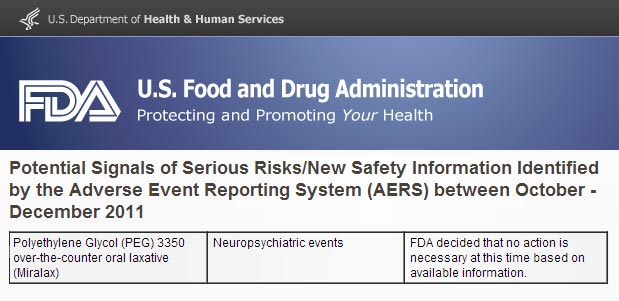Here's an article I found. I use Miralax myself, never thought about anti freeze? Maybe just drink prune juice. My mom used Miralax and she lived to be 91.
VIOXX?
Getting mad or forgetful after taking a laxative? Well, according to the US Food and Drug Administration that’s exactly what certain best-selling laxatives can do to you.
Back in December of 2011, the FDA placed MiraLAX — a polyethylene glycol-containing blockbuster drug marketed by Merck & Co — on its Adverse Event Reporting System (AERS) in connection to “neuropsychiatric events.”
Besides MiraLAX, this warning also applies to Movicol, Dulcolax, Colyte, Colovage, Co-Lav, Clensz-Lyte, ClearLax, GoLYTELY, GaviLyte C, GlycoLax, Go-Evac, GlycoPrep, E-Z-Em Fortrans, Halflytely, Lax-a-Day, LaxLyte, MoviPrep, Macrogol, NuLytely, OCL, Peg-Lyte, Prep Lyte, Softlax, TriLyte, and all other brands with Polyethylene Glycol 3350 (PEG for short) as their active ingredient. The “3350” qualifier refers to the molecular weight of this particular variant of PEG.
The cutout from the MiraLAX-related posting on the FDA's website [
1].
Polyethylene glycol is made by stringing together molecules of ethylene glycol into a large polymer chain, hence the prefix
poly-, Greek for
many. On its own, ethylene glycol is used in automotive antifreeze and brake fluid. According to the National Institute for Occupational Safety and Health, it is an extremely toxic substance:
“Ethylene glycol is chemically broken down in the body into toxic compounds. It and its toxic byproducts first affect the central nervous system (CNS), then the heart, and finally the kidneys. Ingestion of sufficient amounts [as little as 30 ml — KM]
can be fatal.” [
2]
The term “neuropsychiatric events” in the FDA's safety alert refers to neurologic disorders of the central and peripheral nervous systems such as autism, dementia, depression, schizophrenia, multiple sclerosis, Alzheimer’s and Parkinson’s diseases, and similar others [
3]. These conditions result from PEG's direct (through cellular damage) and indirect (through malnutrition of essential micronutrients) neurotoxicity. No surprise there considering the quotation above.
Lead, mercury, and arsenic are some of the best known neurotoxins. So are snake venom, curare, botulinum, and tetanus. PEG is more like lead or mercury — slow-acting, insidious, and difficult to pin down conclusively onto a variety of “slow-brewing” neurological disorders.
In addition to neurotoxicity, the following serious complications have been associated with polyethylene glycol-containing laxatives:
●
Nephrotoxicity: PEG has been connected to nephrotoxicity — an euphemism for kidney damage — when used as a drug solvent [
link,
link] or when applied to skin [
4]. For these reasons PEG is contraindicated for patients with kidney disease. This particular “side effect” is most likely related to the hydrolyzed (separated in water solution) molecules of ethylene glycol.
●
Urticaria: PEG may cause allergy-related hives (urticaria) — raised red welts on the surface of the skin. Children are particularly susceptible to hives, and face a grave risk of anaphylaxis — a life-threatening allergic reaction that may develop within minutes or even seconds after ingesting a PEG-containing laxative. Links between PEG and urticaria have been documented as far back as 1991 [
link].
●
Esophageal perforations: Also known as Mallory-Weiss tear, esophageal perforations associated with polyethylene glycol electrolyte lavage solution have been reported as far back as 1991. These tears and related bleedings may occur in the mucus membrane of the lower part of the esophagus, or upper part of the stomach [
link].
This particular side effect isn't directly related to MiraLAX which is taken in smaller doses, but the potential is always there, particularly among young children or patients with GI tract obstruction that may initially manifest itself as constipation.
●
Encopresis. The involuntary passage of stools in toilet trained children is one of the nastiest side effects of taking PEG-containing laxatives. The same condition may affect adults, and for the same reasons — a continuous leakage of semi-formed stools from the large intestine, an outcome of PEG “working” too well.
All of the “collateral damage” from PEG shouldn't surprise anyone, least of all seasoned chemists, pharmacists, and medical doctors. This industrial chemical is manufactured by The Dow Chemical Company for use in wood treatments, paints, coatings, rubber, textiles, detergents, and toilet bowl cleaners [
5].

